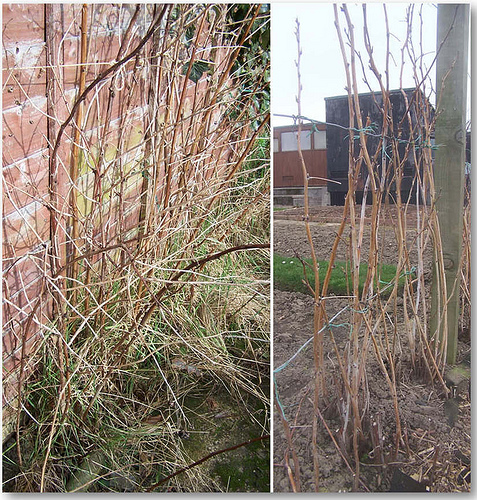



Raspberries for some reason are often considered to be second best in comparison to strawberries. Maybe they can be a little more trouble to grow but the benefits of growing raspberries by far outweigh and effort needed to grow them.
We had inherited a thicket of raspberry plants that had in effect gone wild and produced very little fruit. We decided that these would be removed which was easier said than done as they had produced a dense thicket of suckers. We still have some that refuse to die.
We decided to buy late summer fruiting varieties as we already had some earlier varieties in our home garden. Although these are quite ancient now they still provide us and the blackbirds with a constant supply of tasty fruits.


We decided to go for a red variety – Joan J and a yellow variety – All Gold. Neither plant produces tall canes and therefore it has been unnecessary to support them. We bought 12 canes of each variety and planted one row of each variety in the designated bed. The bed is surrounded by grass paths so the mowing and strimming of the grass keeps the suckers in check.
Both plants produce fruit from about late July until the first frosts. Since the plants have matured they have produced a continuous supply of raspberries throughout this period.
Of the two varieties All Gold is slightly stronger growing and grows a little taller than Joan J but both seem happy share the same bed. Joan J has much smoother less prickly stems.
Although many consider it to be crucial to net raspberries to protect them from birds we have never found this necessary. Maybe we are lucky on our site but few people tend to bother to net their raspberries. In the garden a blackbird often screeches off when I go to pick some berries but the birds leave more than enough berries for us.

As mentioned previously both of these varieties are late summer fruiting or ‘primocane’ varieties.
This means that they fruit on new wood or canes produced in the same year.
Once a cane has finished fruiting it can be pruned to ground level.
Once the weather was dry enough and the temperature not too cold – for my comfort rather than anything to do with the plants I decided to prune. This year that was late February.
Every cane is cut down to ground level – mine had even started to produce this year’s fruiting shoots so care had to be taken not to damage these.
Having cut back lasts year’s canes I weeded around the plants and will treat them to a feed of blood, fish and bone fertilizer.
The plants will also benefit from a mulch to keep down the weeds.
I have absolutely no idea what variety the ones growing in the garden are. Neither can I remember just when we planted them other than it was a very long time ago. Apparently after about 8 years the canes should deteriorate but these are well over eight years old and if they have deteriorated they still produce a good crop of berries. Not only are they old but they have never been fed and grow alongside a fence in – as can be seen from the photograph in a very neglected bit of soil. The bed – if it can be called that -is about 15 centimetres wide and the roots are choked with grass. All I know is that the fruits are red and produced in early summer fruiting ones. Apparently these are called floricane varieties which mean that they fruit on canes produced during the previous year.

Early summer varieties require a totally different pruning method. In spring all old canes which fruited last year are cut out completely leaving several new canes to grow on. The old canes are a darker colour and often show the remains of last year’s fruits. The remaining canes should then be tied in to support wires as shown in the photograph of ones already pruned on a neighbouring plot. The canes in our garden grow quite long and so I arch them over and tie the ends to the wires. This means that the fruit are in easy reach and also is said to encourage heavier fruiting.
One of the only drawbacks with raspberries is that wet fruit soon goes mouldy and last year’s wet summer produced just the conditions for this to happen. That said we still had plenty of berries each week during late summers and also plenty to freeze – raspberries freeze particularly well - or make up into jam.
As an addition to our raspberry collection we have ordered a clump forming variety called Glencoe which is new to this year. This is a late summer fruiting variety which is apparently a cross between a raspberry and an American Black raspberry. It is supposedly a heavy cropper, producing ‘intensely flavoured’ fruits and resistant to many raspberry diseases. The fruits are a deep purple and each plant is said to produce a multi-stemmed clump. It is supplied as one pot grown plant and the cane are spineless so less pain when pruning and picking. It should be interesting to see what it produces and whether it lives up to such great expectations.











